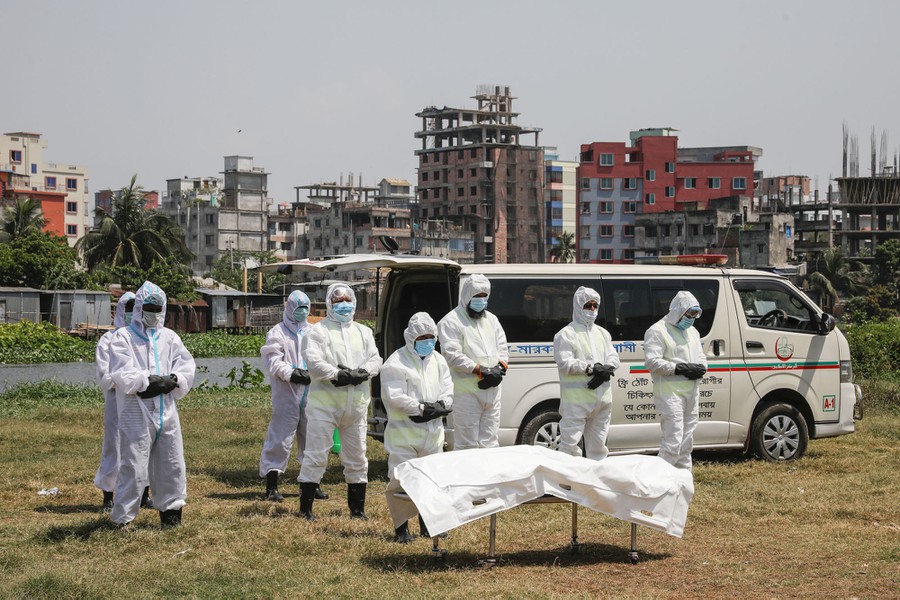Protect nature stay safe!
Arindam Bala:
Since the inception, human beings lived in the kingdom of nature. Human health and environmental health is interrelated. For the survive all living organisms rely on the environment. And it is thought that the environment is also an integral part of our development model. But for couple of decades, the environment approach has been sharply changing resulting natural calamity like cyclone, tornado, flood, earthquake, landslide, drought, sea level rising, salinity, river erosion are increasing many folds than previous. And every year animal-borne viruses have emerged from nature that may rise steeply over the upcoming decades.

Deadly novel coronavirus are currently creating unprecedented death. It is assumed that the novel coronavirus has come from ‘Bats’. Here, it is pointed that due to consume such wildlife, the zoonotic deadly disease like Covid 19 has probably emerged. And, it is learned that some earlier deadly viruses have come from wildlife -Bats, Civet Cats, Snake, Pork and camel. In the modern world, there are national and international wildlife (snake, bats and pangolin) trade networks for strengthening supply chain of wildlife to the consumers consequently wildlife are vanishing very rapidly. Due to continuation of trade people are coming very close of wildlife species that have created a high risk of spreading diseases.
The 2020 Living Planet Index shows an average 68% decline in global vertebrate species population- mammals, birds, amphibians, reptiles and fish-in less than of half century. And The Living Planet Report 2020 (LPR) illustrates that global biodiversity loss is its worst. It is also depicted that in North America, nearly 3 billion birds lost in the past 50 years. 30% of its plant-pollination network has disappeared. In Asia pacific nearly 3 billion animals were killed or displaced by Australia’s bushfire of 2019 and 2020. And more than 80% of East and Southeast Asia’s wetlands are classified as threaten due to human activities. In the report five majors threat categorizes were used to illustrate the impacts that are driving biodiversity decline. Those are A. Land and Sea use change B. Pollution C. Species overexploitation D. Climate Change and E. Invasive Species and disease.

Air pollution kills an estimated seven million people worldwide every year says World Health Organization (WHO), and its data shows that 9 out of 10 people breathe air containing high levels of pollutants. ”Air pollution is linked to significantly higher rates of death in people with Covid-19, ” (Source-The Guardian). Bangladesh is ranked as the most polluted country in the world since 2018. According to the State of Global Air Report 2020- with annual average PM 2.5 concentrations of 77.1 microgrammes per cubic metre, Dhaka ranked the second most polluted capital cities in the world while Delhi is first. Water is also another crucial element of environment. 
United Nations reported 1 in 3 people live without safe drinking water. By 2025, half of the world’s population will be living in water stressed area. According to a recent UNDP survey report (66,234 household and 271,464 population surveyed), 73 % of the people living in five coastal upazilas–Koyra, Dacope, Paikgachha of Khuklna and Assasuni and Shyamnagar of Satkhira–have to drink unsafe saline water. And even day into day out, the open water bodies are decreasing. For instance, history says that the number of river in Bangladesh was 776 at time, but they are now only 240 in number. Besides water and air pollution, soil is losing its fertility due to several causes, too.
Soil, it is extremely precious element for keeping balance for all living and non-living organism interaction. The produced industrial hazardous waste disposal, plastic materials, chemical waste, nuclear waste and illegal dumping are principal factors in triggering the soil based pollution affecting plants, animals and human. According to report of FAO 2018, global production of municipal solid waste was about 1.3 billion tonnes per year in 2012; it is expected to rise to 2.2 billion tonnes annual by 2025. 
Forest ecosystems are a critical component of the biodiversity, but man-made deforestation causing negative impact on the forest ecosystems. According to FAO, the state of the world’s Forest 2020, ”between 2015 and 2020, the rate of deforestation was estimated at 10 million hectors per year. Since 1990, the area of primary forest worldwide has decreased by over 80 million hectors”. Tropical rainforest, harbor 50% of world’s biodiversity, is most important. But it is sharply declining the rate of it’s at near 2% annually. And it is thought it will hit 10-25% of by late 21st century. Due to deforestation, excessive pollution, and overexploitation mangroves are disappearing three to five times faster than overall global forest losses.
In our country, a good number of initiatives have been taken for preventing environmental degradation. Some of them are mentioned below-
A. The forest Act (1927)
B. Formation of The Ministry of Environment and Forest (1972), renamed The Ministry of Environment, Forest and Climate Change (2018)
C. The National Environment Policy (1992)
D. The Environment Conservation Act(1995)
E. The Environment Conservation Rules (1997)
F. Bangladesh Wetland Policy (1998)
G. National Water Policy (1999)
H. National Land Use Policy (2001)
I. The Environment Court Act (2010)
J. The wildlife (Conservation and Security) Act 2012. Currently this legislation is acting as the legal document for conservation of wildlife and biodiversity in Bangladesh.
K. The Bangladesh Water Act (2013)
L. The Bricks Manufacturing and Brick Kilns Establishment (Control) Act 2013
M. The Bangladesh Biodiversity Act (2017)
It is important now; the authorities need only implementation the enacted laws and take concrete measurement for protect the fragile environment. So, from all level we have to recommit for stopping environmental destruction for saving world human beings.
At the global level, the Convention on International trade in Endangered Species of Fauna and Flora (CITES) is responsible for monitoring the wildlife trade. For preventing such zoonotic disease, major step would be on banning all animals’ trade locally, nationally as well as internationally. Overexploitation and consumption of wildlife have to be controlled.
Currently, talk of the world is Covid 19 and climate crisis. It is clear the both are interlink with nature. Here, deforestation is one of the principal causes. As many sources are telling that deforestation has reached at alarming level. So, first step should be reforestation instead of deforestation over the world. 
According to Department of Environment Brick ‘kilns are the top air polluter in seven major cities in Bangladesh, and there are about 6,500 brickfields’. World Bank report-2016 says that brick kilns emitting 9.8 million tonnes of greenhouse gas annually. Here, eco-friendly bricks (green bricks) that has already introduced can prevent large part of air pollution. In order to reduce water pollution, the waste of industries and widespread plastic has to be recycled rather than throw into water in the river and water body. Water bodies have to be enabled for retaining water for filtering environment. Here, Effluent Treatment Plant (ETP) has to mandatory for all industries and factory for recycling waste water otherwise day into day out the open water source will not be remained without contamination as all waste water flows towards canal, river and finally ocean. And proper waste management and recycling must be helpful for plummeting soil contamination. Besides this, farmers have to be encouraged for using organic instead of chemical and pesticide.
There are many species like frogs we know that frogs eat mosquitoes which carry deadly virus. It is clear that if these species are disappeared from the nature, the humans are more likely to be infected from such virus career. So, we have to ensure enable natural environment for those species for breeding and living and consuming deadly virus career insects that is also crucial for ecosystem cycle.
In the meantime, in small scale some countries around the world are emphasizing on using renewable energy collecting from renewable sources like sunlight, wind, rain, tides, waves and geothermal heat contributing more than 20 percent of energy supply. Though renewable systems are rapidly becoming more efficient, it should be expanded large scale in developed, developing and least develop countries for protecting environment.
Here, Covid-19 has shown us how the environment could be decontaminated and reduced pollution. In order to combat the deadly coronavirus pandemic fresh lockdown was imposed last year resulting in some cities over the world saw a drop of nearly 50 percent air pollution. It is proved; lockdown is one kind of best measures for reducing air pollution. So, lockdown could be practiced for a certain time now and then where all carbon emission activities would be closed except people movement on foot, by rickshaw, van and bicycle.
The USA world’s second biggest emitter of greenhouse gas is now committed to halving emission 50-52 percent (from its 2005 levels) by 2030, and the UK pledged to reduce carbon emissions by 75 percent by 2030. This promise must open new windows for mitigating climate crisis.
Nature is sending us a message with the coronavirus pandemic and the ongoing climate change, said UN’s environment chief, Inger Andersen. So, it is clear, if we want to live and create congenial environment for our future generation in the Earth, all environmental pollution has to be reduced at nay how. Otherwise such virus related pandemic and natural disaster will appear taking much strength and claim uncountable beloved that is now happening. From this global pandemic there are some lessons learned for moving forward to prevent future pandemic. We recently celebrate ‘Earth Day’. The theme of this year is ʺTogether, We Can Restore Our Earthʺ. Really it is high time to restore our Earth where from village to national to global all have to take part. The world leaders will meet at COP26 to be held in November in Glasgow. We hope from the conference a new horizon will come out for sustainability of our environment for better tomorrow.
The writer is an environmental activist and development worker. He can be reached at [email protected]
































